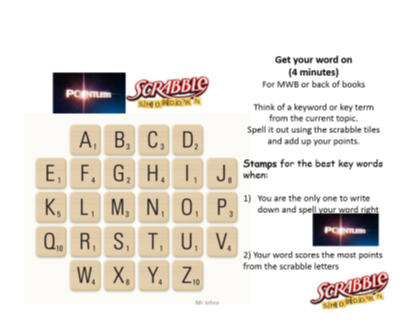Stretch and challenge is one of latest buzz words in education. I see it as more than “gifted and talented” which focuses on the few. Stretch & Challenge is for all. Every student should be stretched and challenged, as basic differentiation regardless of ability.
Here are some examples of starters I have used:
- Curriculum Links: Allow your students to make links to all areas of the curriculum from the topic you are studying:IE: if you are covering atomic theory can you link aspects to the following. There could be an opportunity to award points [insert….school behaviour reward here]. More points could be awarded for harder to link to subjects:
| English | D+T | Geography | Art |
| Careers | History | Business Studies | ICT |
| Food Tech | PE | Maths | MFL |
2. Anagram Starter: Jumble up a keywords and key terminology for students to unjumble
ESCNIEC : Science
SGIHNLE: English
3. Retrieval Quizzes: After I watched Follow @AceThatTest present a keynote at a Follow @wctsa teachmeet I went away and reflected on improving my starters.to include the idea of retrieval practice http://www.learningscientists.org/blog/2016/6/23-1 I now attempt to give all my students 5 to 8 questions based on previous lessons, topics and even questions from previous years and sciences. I did these very simply as a list – a few months later I came across a much better student -friendly design by Follow @87history .
Download an example for FREE here
https://www.tes.com/teaching-resource/physics-retrieval-quiz-energy-waves-and-electricity-11814407
4. Odd one out: Give students 4 pictures and ask them to point out the odd one out and the reasons why?
5. What Dat Picture: have a photo on the board [as a hook…] and ask students what questions the picture brings to the surface and/or how it links to their work.
6.Scrabble/Pointless: Use the scrabble tiles for students to rearrange to create keywords and terms from topics, getting them to add the points together. Include Pointless into this if there is a word that only one student has written down.

Science can add to this by creating words from the symbols of elements of the periodic table. Students can then add up the atomic masses.
Remember points win prizes
Template can be downloaded here: https://www.tes.com/teaching-resource/a-scrabble-and-pointless-game-starter-activity-11854487
7. Thunk: From independentthink.co.uk:
- A Thunk is a beguilingly simple-looking question about everyday things that stops you in your tracks and helps you start to look at the world in a whole new light. discussion and debate
Such as:
- Should cyclists be fined for speeding?
- Where does the horizon start?
- If you had £500,000 what scientific research would you do?
- What colour is Physics?
- If you had £500,000 what scientific research would you do?
More examples can be found here:
8. Well Rounded: Give students a topic and let them explore it with helpful hints:
Who gains from it?
Who loses out?
What are the financial issues?
What are the unanswered questions and issues?
9. 6 degrees of separation: https://www.youtube.com/watch?v=TcxZSmzPw8kPick two random areas from topics (they can be different) and ask students to try and link them in 6 steps.
10. Reverse Questioning: Give students the answers to questions and get them to write the questions and/or calculations. If you are giving a number answer – then remember to include the units.
11. Strip Starters: Hand out to students as they enter the room and get them to stick in their books and answer the questions next to them. Another take on the retrieval quiz.
Find an example to download here: https://www.tes.com/teaching-resource/aqa-1-9-energy-starter-strip-11847566
12. Question Developer: Get students to write their own probing questions using these prompts

13. Who am I? This can be extended or shortened depending on the group. How did you get on with this one?
5 points: I was born on the 8th October 18503
4 points: I was born in Paris, France
3 points: My field of science was Chemistry
2 points: My research centred around changes in concentration, temperature & pressure
1 point: The principle named after me is used by chemists to predict the effect a changing condition has on a system in chemical equilibrium
Name: Henry Louis Le Chatelier
And some further watching:
Who is Le Chatelier? https://www.youtube.com/watch?v=XmgRRmxS3is
What is equilibrium? https://www.youtube.com/watch?v=dUMmoPdwBy4
14. Dingbats: use pictures to describe a saying or keyword.Any thoughts on this one?

Robert Hooke’s Law to find the Spring Constant
15. Code Breakers: Give students a topic and put the keywords in a code (IE A= 1 B =2) students then have to rearrange.
16. Quotes A: Give students related to a topic but put synonyms in place of the key terminology. Students then have to alter it.
17. Quotes B: Give students a piece of text but change some of the words and key terms. This could be grammar or incorrect information. Students need to correct them all.
18. What will you ask them? Show a photo of a famous person and ask students to write down questions they would want to ask them? IE what would you ask Charles Darwin?
19. What happens next? Show students a picture or a series of pictures and ask them what happens next? Encourage deeper thinking skills.
20. A to Z: A longer activity than a short engaging starter – but get students to find a keyword for a topic beginning with A to Z.
If you have any more ideas share them and let me know on twitter:
Follow @TJohns85

4 thoughts on “20 starter activities to stretch & challenge students”